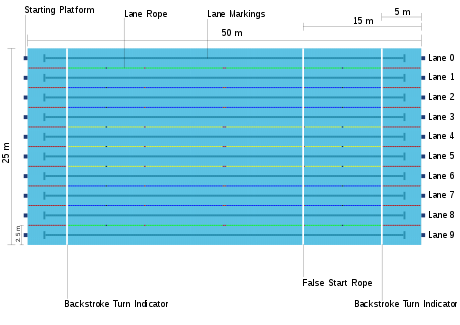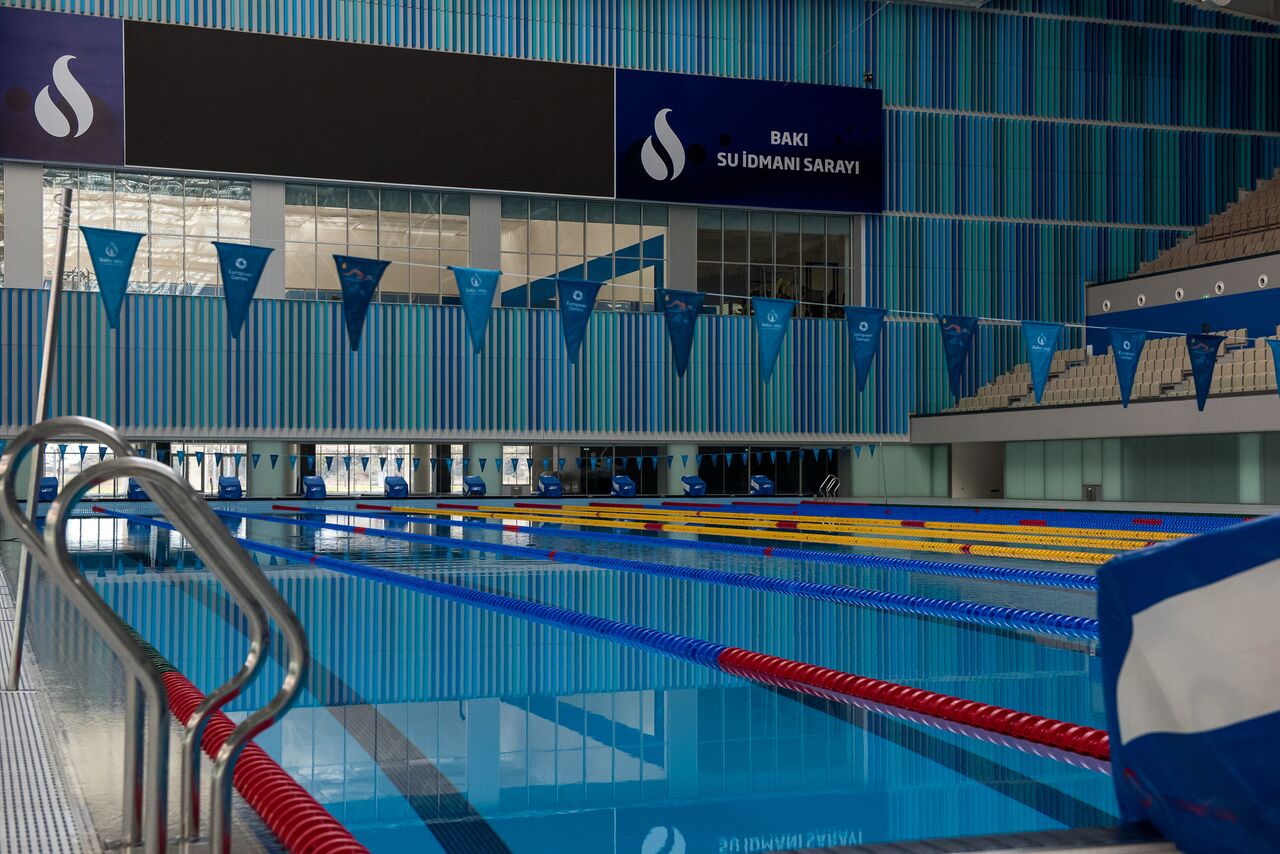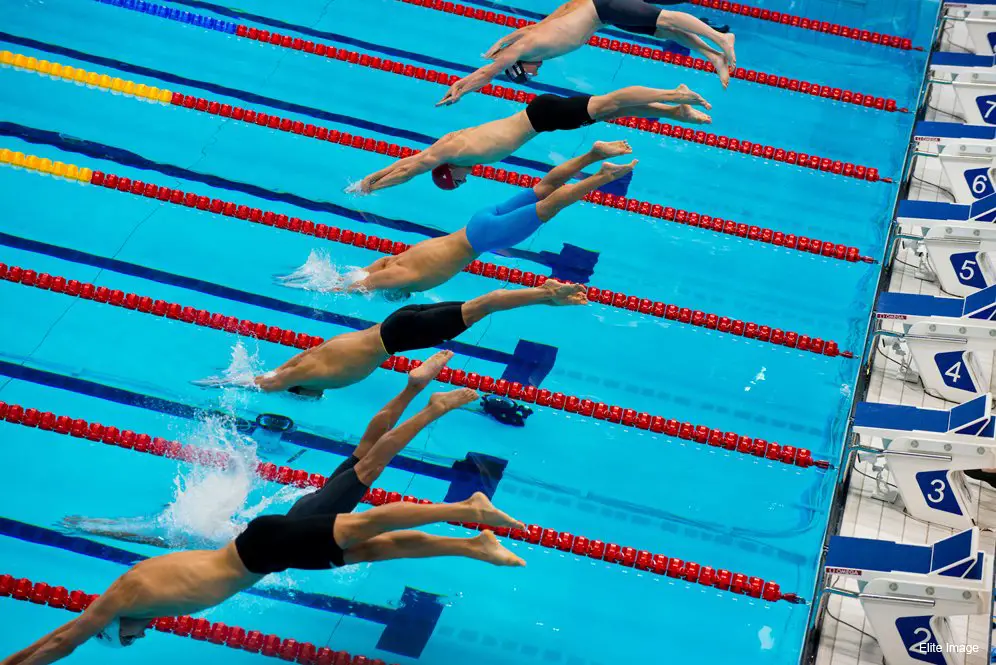Olympic swimming pools are typically 50 meters long. These pools are used in competitions at the Olympic Games and meet the standards set by the International Swimming Federation (FINA).
Swimming is a highly popular and competitive sport that has been a part of the Olympic Games since its inception. The length of an Olympic swimming pool is standardized to ensure fairness and accuracy during races. These pools are designed to be 50 meters long, providing enough distance for athletes to showcase their skills and stamina.
With their precise measurements, Olympic swimming pools offer the ideal environment for swimmers to achieve their best times and records. The length of these pools is carefully maintained and regulated by FINA, which sets the standards for international swimming competitions. By adhering to these guidelines, Olympic swimmers have a level playing field to showcase their talent on the world stage.
The Dimensions Of Olympic Swimming Pools
When it comes to the competitive world of Olympic swimming, the dimensions of the swimming pool play a crucial role in setting the stage for athletes to showcase their skills. The standard length and regulation depth of an Olympic swimming pool are key components that make it suitable for world-class competition. Let’s dive into the specifics of the dimensions of Olympic swimming pools.
Standard Length
An Olympic swimming pool has a standard length of 50 meters. This substantial length provides the ideal distance for swimmers to compete in long-distance races, such as the 1500-meter freestyle and the 800-meter freestyle relay. The length of the pool is perfectly designed to test the endurance, technique, and speed of the swimmers, creating a challenging yet fair environment for competition.
Regulation Depth
Regulation depth is a critical aspect of Olympic swimming pools. The depth of an Olympic swimming pool is 2 meters throughout the entire length. This uniform depth ensures that swimmers can safely dive, turn, and push off the walls without the risk of injury. The consistent depth provides a level playing field for all competitors, allowing them to focus on their performance without concerns about varying pool depths.

Credit: en.wikipedia.org
Comparison To Standard Pools
When it comes to Olympic swimming pools, there are a few key differences to note when comparing them to standard pools. The lengths and depths of Olympic pools, for instance, are designed to meet specific requirements for international competitions. Let’s take a closer look at the disparities regarding length and depth.
Length Disparity
Olympic swimming pools are considerably longer than standard pools. While the length of a standard pool typically ranges from 25 to 50 meters, Olympic pools are set at a fixed length of 50 meters. This extra length not only allows for more competitive swimming but also better accommodates larger audiences during major events.
Depth Discrepancy
Unlike standard pools, which may have varying depths to cater to different types of swimmers, Olympic swimming pools have a consistent depth. The Olympic pool’s depth is maintained at a minimum of 2 meters throughout, ensuring that it meets the safety and fairness standards set by international governing bodies such as FINA (Fédération Internationale de Natation).
The uniform depth also benefits swimmers by minimizing turbulence and water resistance, providing a predictable environment for the athletes to achieve optimal performance.
Engineering Feats In Construction
Engineering feats in construction: How Long are Olympic Swimming Pools
Structural Requirements
Olympic swimming pools are incredible engineering marvels, designed to meet specific structural requirements to ensure fair and competitive race conditions. These pools have stringent guidelines for their dimensions, depth, and overall design.
- Dimensions: Olympic swimming pools must measure 50 meters in length. This distance allows for standardization in international competitions and ensures consistent records can be set.
- Depth: The depth of Olympic swimming pools can vary depending on the area of the pool. The minimum depth for the competition area is 2 meters. This depth allows for swimmers to dive in safely and prevents waves from bouncing off the pool walls, disrupting the rhythm of the race.
- Design: The design of Olympic pools is carefully planned to minimize turbulence caused by swimmers. This reduces drag and ensures fair competition. The pool walls are specially designed to absorb waves and prevent them from bouncing back. The shape of the pool is typically rectangular, allowing swimmers to optimize their strokes and turns.
Water Filtration Systems
In addition to their structural design, Olympic swimming pools also utilize advanced water filtration systems to maintain the highest standards of water cleanliness. These systems are essential for the health and safety of the athletes, as well as ensuring optimal swimming conditions.
- Filtration: Olympic swimming pools employ elaborate filtration systems that continually remove impurities, such as dirt, debris, and bacteria, from the water. These systems consist of a combination of sand filters, mechanical filters, and chemical treatments, ensuring the water remains clear and free from any contaminants.
- Circulation: The water circulation system in Olympic swimming pools helps maintain uniform water temperature and chemical balance throughout the pool. This ensures that the swimmers have consistent conditions and prevents any hot or cold spots that could affect their performance.
- Monitoring: Olympic swimming pools are equipped with advanced monitoring systems that constantly measure the water quality. These systems provide real-time data on chemical levels, pH balance, and water clarity. If any irregularities are detected, immediate action can be taken to rectify the issue and maintain optimal water conditions.
:max_bytes(150000):strip_icc()/RioOlympicsswimmingpool-GettyImages-519838356-59c09963054ad90011cf5247.jpg)
Credit: www.liveabout.com
Challenges For Athletes
Apart from showcasing incredible athleticism and a relentless drive to win, Olympic athletes face numerous challenges when it comes to competing in swimming pools. These challenges range from adjusting their technique to enduring grueling training regimens. In this article, we will explore the specific challenges that Olympic swimmers encounter and how they overcome them to achieve greatness in the pool.
Adjusting Technique
One of the major challenges for Olympic swimmers is adjusting their technique to meet the requirements of different pool sizes. Olympic swimming pools can vary in length, but they are typically 50 meters long. However, not all pools conform to these dimensions. For instance, some temporary or training pools may be 25 meters or even smaller, considerably restricting the swimmers’ strokes and kick actions. This variation in pool length can pose a significant challenge for athletes who need to adapt their technique accordingly.
Endurance Training
Endurance is a critical factor in competitive swimming, and Olympic athletes must undergo rigorous training to build and maintain their stamina. Swimming long distances in Olympic-sized pools demands exceptional cardiorespiratory fitness. The longer the race, the more endurance an athlete requires. Swimmers have to consistently train for hours on end, pushing their bodies to the limit to build up their endurance levels and prepare for intense competition.
Influence On Competitive Performances
When it comes to Olympic swimming pools, the length of the pool has a significant influence on competitive performances. Understanding the impact of pool length is crucial for swimmers and spectators alike. In this article, we will explore the various ways in which the length of the pool affects speed records and swimmers’ strategies.
Speed Records:
Speed records in swimming are constantly being broken, and the length of the pool plays a vital role in this achievement. The standard pool length for Olympic competition is 50 meters. This allows swimmers to fully demonstrate their speed and endurance as they compete against each other and the clock.
Swimming in a longer pool provides a greater distance for swimmers to reach their top speed. This longer distance allows for more powerful and sustained strokes, resulting in faster times. Additionally, the longer pool allows swimmers to maintain their momentum for a longer duration, contributing to improved overall performance.
Impact On Swimmers’ Strategies:
The length of an Olympic swimming pool also influences swimmers’ strategies. In shorter pools, such as those used for short course competitions (25 meters), swimmers need to focus on a different set of skills and tactics.
Shorter pools require swimmers to execute quicker turns and transitions, as they have fewer strokes and less distance to make up for any lost momentum. These pools demand precision and agility, as swimmers must navigate the turns swiftly and efficiently to minimize time lost.
On the other hand, longer pools allow swimmers to adopt different strategies. They have more room to adjust their pacing and use their endurance to their advantage. In races spanning multiple lengths of the pool, swimmers can strategically increase or decrease their speed at specific points to maximize their performance over the entire race.
Regardless of the length of the pool, swimmers must adapt their techniques and approaches to ensure they utilize the pool’s dimensions to their benefit. Understanding the nuances of pool length is essential for swimmers aiming to reach their full potential.

Credit: en.wikipedia.org
Environmental And Economic Considerations
The environmental and economic considerations of Olympic-sized swimming pools play a significant role in the decision-making process for hosting major aquatic events. Understanding the water usage and cost of maintenance is crucial for both sustainability and financial planning.
Water Usage
When it comes to water usage, Olympic-sized swimming pools consume a substantial amount of water. The average pool holds about 2.5 million liters of water, which may vary depending on the specific dimensions. This high consumption calls for sustainable water management strategies, including efficient filtration and recycling systems.
Cost Of Maintenance
The cost of maintenance for Olympic swimming pools encompasses various factors, such as filtration, treatment, and energy expenses. Regular cleaning and monitoring are essential to ensure water quality and uphold the facilities’ integrity. Additionally, the need for skilled labor further contributes to the overall financial investment in pool maintenance.
Global Spread Of Olympic-sized Pools
Discover the standard length of Olympic swimming pools, which span 50 meters, symbolizing an international athletic measure. These pools, known for their colossal size, are prevalent worldwide, offering a consistent dimension for competitive aquatic events.
Global Spread of Olympic-Sized Pools: Olympic-sized swimming pools have become a standard feature in sports facilities worldwide. These large pools, measuring a whopping 50 meters in length, play a crucial role in training athletes and hosting major swimming events. But how common are these pools beyond Olympic arenas? Let’s explore the global reach of these iconic swimming facilities.
Adoption In International Competitions:
Olympic-sized pools are now a common sight in international competitions such as the FINA World Championships and Commonwealth Games. These pools ensure a consistent and fair playing field for swimmers from different countries and continents, maintaining the integrity of the sport.
Accessibility For Public Use:
Apart from elite competitions, Olympic-sized pools are also accessible to the public in many countries. People of all ages and skill levels can benefit from these pools for swimming lessons, recreational activities, and fitness training. This widespread availability promotes the popularity and importance of swimming as a sport and physical activity. By offering Olympic-sized pools for both elite competitions and public use, countries around the world are embracing the significance of these iconic swimming facilities.
Innovations And Future Trends
As the world of competitive swimming continues to evolve, innovations and future trends in Olympic swimming pools play a vital role in shaping the sport. From advancements in pool design to sustainability initiatives, the pursuit of excellence is driving the development of Olympic swimming facilities.
Advancements In Pool Design
Innovations in pool design have revolutionized the way swimmers train and compete. The quest for faster times has led to the development of deeper pools with state-of-the-art starting blocks and underwater LED lights. These advancements not only enhance the performance of athletes but also provide spectators with an immersive viewing experience.
Sustainability Initiatives
Sustainability initiatives are shaping the future of Olympic swimming pools. From solar heating systems to recycled material construction, venues are incorporating eco-friendly practices. These efforts not only reduce the environmental impact but also inspire a new generation of swimmers to embrace the value of sustainable living.
Conclusion
After learning about the lengths of Olympic swimming pools, it’s clear how crucial precision is in competitive swimming. Understanding the standard dimensions of these pools is vital for both athletes and enthusiasts. Dive into the world of swimming knowing the exact measurements for an exhilarating perspective on this sport.





